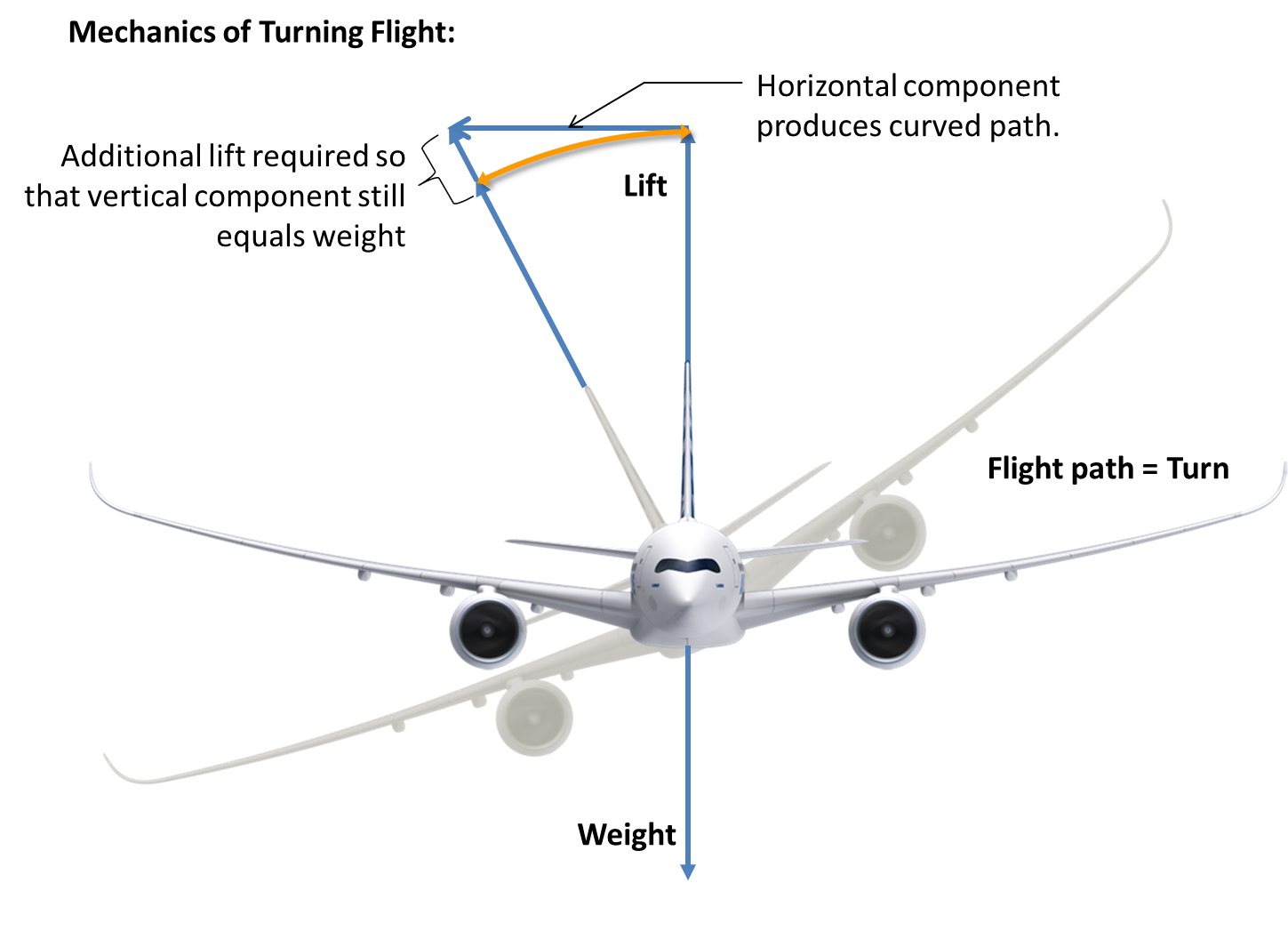Load Factor Aircraft - In aerodynamics, the load factor (at bank angle) is the ratio between lift and weight and has a trigonometric relationship. The load factor is measured in Gs (speed of gravity), a component of the force equal to the force of gravity on the body at rest and shows the force that the body exerts when climbing. Any force that an airplane uses to deviate its flight from a straight line makes the airplane difficult. This amount of energy is a property. Although training in aerodynamics is not required to obtain a pilot's license, the pilot must have a thorough understanding of the forces acting on the aircraft, the proper use of these forces, and the limits of the aircraft control.
For example, a load of 3 means that the total load on the floor is three times its weight. Since loads are defined in terms of Gs, a quantity of 3 can be called 3 Gs, or a quantity of 4 as 4 Gs.
Load Factor Aircraft

If the plane is towed from the ground, and subject the pilot to 3 Gs, it will be pressed against the seat with a force equal to three times its weight. Since modern airplanes operate at much higher speeds than previous airplanes, increasing the ability to transport large cargo items, this result has become an important factor in the design of all airplanes.
Electric Airplane Industry & Trends
With aircraft design designed to support minimal overload, knowledge of load management has become essential for all pilots. Weights are important for two reasons:
The answer to the question "How powerful should an airplane be?" is mainly determined by the use of the aircraft. This is a difficult problem because most of the possibilities are too high to be used for efficient production. It is true that any pilot can land too hard or pull too much when jumping, which can create a difficult load. However, such heavy loads must be removed if the aircraft are designed to take off quickly, land slowly and carry the required load.
The problem with load factors in aircraft design is how to determine the maximum load factors that can be expected to be effectively carried out under various conditions. These load factors are called "limit load factors". For safety reasons, it is necessary that the aircraft be designed to withstand these conditions without structural damage. Although the Code of Federal Regulations (CFR) requires that the structure of the aircraft can support one and a half of these heavy loads without failure, it is accepted that some parts of the aircraft may bend or bend under this load and damage the structure. it can happen.
The above applies to all open systems, whether due to wind, maneuvering, or landing. The flavor load factor requirements are now very similar to what they have been for many years. Hundreds of thousands of hours of work have proven that it is enough for safety. Since the pilot has little control over the flow (other than reducing the aircraft's speed when rough air is encountered), the air handling requirements are very similar to those of most commercial aircraft. any type, regardless of its function. In many cases, the flight control system controls the design of aircraft that are designed for non-commercial use.
The Algorithm Behind Plane Ticket Prices And How To Get The Best Deal
There is a very different approach to aircraft design with control elements. It is important to discuss this issue separately from: (1) aircraft that are designated according to the classification system (ie, exotic, practical, fast); and (2) old designs built to specifications that do not provide functional units.
Aircraft manufactured under this category are easily identified by a sign at the airport, which refers to the service category (or categories) to which the aircraft is certified. The maximum safety (load reduction) specifications for aircraft in different categories are: [Figure 1]
1 For aircraft weighing more than 4,000 pounds, the baggage limit is reduced. For the limit given above, 50 percent protection is added.

There is an increase in weight training and an increase in driving power. A group of groups provides a great opportunity to use the aircraft. If only normal work is desired, the most important factor (and therefore the weight of the aircraft) is less than that the aircraft should be used for training or exercise because it carries a lot of driving load.
Analysis—how Much Money Do Empty Flights Really Cost Airlines
Aircraft that do not have markings of this category are designs that have been designed in accordance with engineering requirements where no restrictions have been imposed on the pilots. For aircraft of this type (up to a weight of 4,000 pounds), the required power is similar to that of modern aircraft, and the same type of work is accepted. For aircraft of this type over 4,000 pounds, weight items decrease with weight. These aircraft must be considered equivalent to the standard aircraft produced under the category, and must be operated accordingly.
At constant height, for uniform rotation in any plane, a heavy object is the result of two forces: centrifugal force and gravity. [Image on page 2] At any bank angle, ROT varies with airspeed - the higher the airspeed, the slower the ROT. This compensates for the increased centrifugal force, allowing the load to remain the same.
Figure 3 shows the important point of the turn - the direction of the load increases to a dangerous level after the bank has reached 45 ° or 50 °. The weight of each floor on the common path on a bank of 60 ° is 2 Gs. The load in the 80° bank is 5.76 Gs. The wings must rise a distance equal to these things if they are to be maintained.
It should be noted how the line that shows the property rises quickly as it approaches the bank line of 90 °, which does not reach because the 90 ° held by the bank, a continuous turn is mathematically impossible. The plane can be set up to 90 ° on the runway if it is not trying to stabilize. An airplane that can glide 90° can fly straight with a knife. At a little more than 80 °, the heavy object exceeds the limit of 6 Gs, the limit of the load of the aerobatic plan.
Bts Statistics Release: April 2016 U.s. Airline Traffic Data
For a coordinated and stable turn, the average bank for most commercial aircraft is 60°. This bank and its consequent power requirements reach the limits of this type of aircraft. An additional bank of 10 ° increases the load by about 1 G, bringing it closer to the center of gravity of the plane. [Image on page 4]
Any aircraft, within its limits, can be stopped at any speed. When a high enough AOA is established, the airflow over the air breaks and separates, creating a sudden change in the shape of the aircraft and sudden loss, which results in a stall.
Research on this has shown that the speed of an aircraft increases in proportion to the root mean square of the load factor. This means that an airplane with a constant ground speed of 50 knots can be stopped at 100 knots by applying a load of 4 Gs. If it were possible for this plane to have a load of nine, it could be stopped at a speed of 150 knots. The pilot must know the following:

Figures 3 and 4 show that the aircraft greater than 72 ° on a slope creates a factor of 3, and the stall speed increases significantly. If this turn is made in an aircraft that has a fixed maximum speed of 45 knots, the speed of the aircraft must be greater than 75 knots to avoid stalling. A similar effect occurs in any fast pull or maneuver that produces loads above 1 G. Sudden, unexpected loss of control, especially during a steep turn or the sudden use of reverse control close to the ground, has caused many accidents.
Loading Graphs And Cg Envelopes
Since the load is doubled when the stall speed is doubled, more load can be placed on the structure by stopping the aircraft at a higher altitude.
The following principles apply to fixed-wing aircraft. The maximum speed at which the aircraft can safely stay is now recognized in all new designs.
This speed is called "design maneuvering speed" (VA), which is the speed below which you can move only one aircraft, at a time, to complete the destruction, in a type of rotation of the aircraft (pitch, roll or yaw), smooth. air, no accident of the plane crash. VA must be entered in the FAA Approved Flight Manual/Pilot's Handbook (AFM/POH) for all newly manufactured airplanes. For old airliners, that is
Occupant load factor table, aircraft load sheet, load factor, load aircraft, occupancy load factor, load factor of aircraft, aircraft jack load testing, boma load factor, resistive load power factor, aircraft load planner jobs, load factor calculation, load factor design
0 Comments